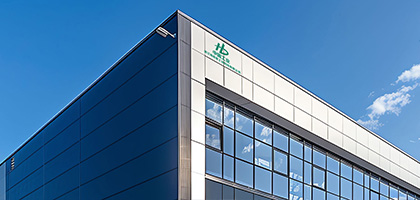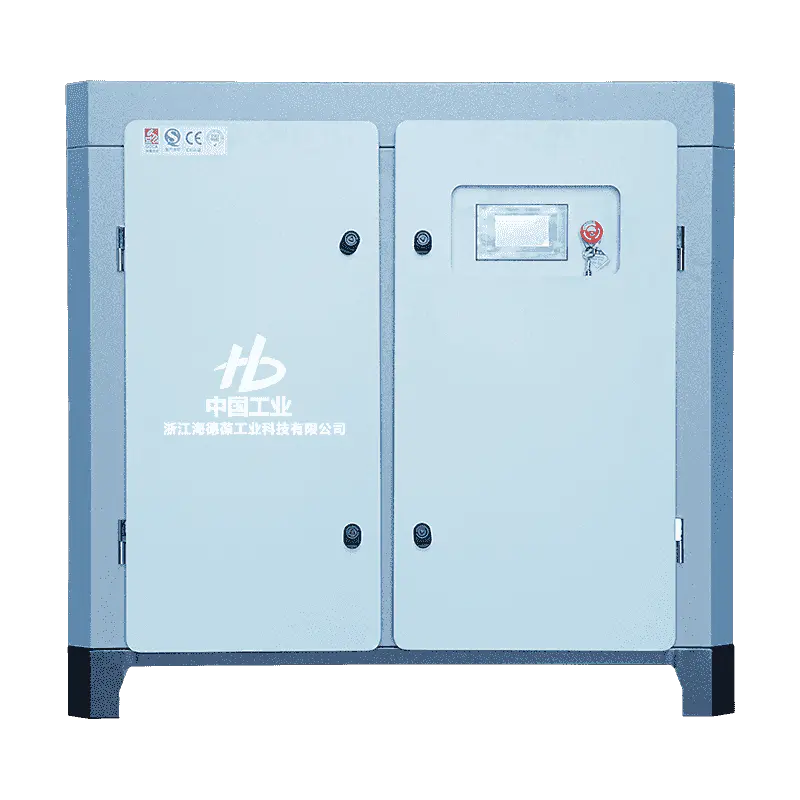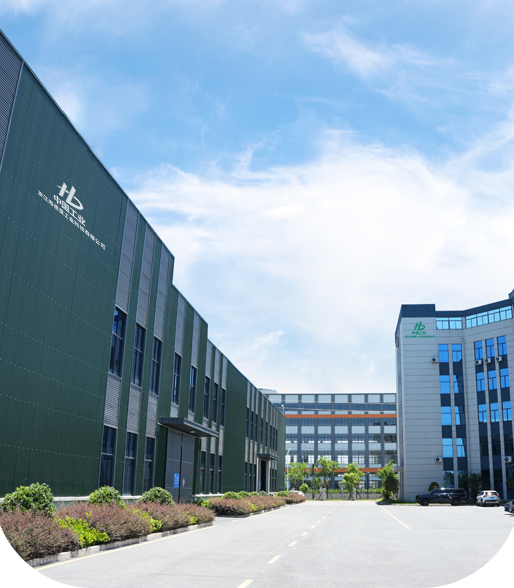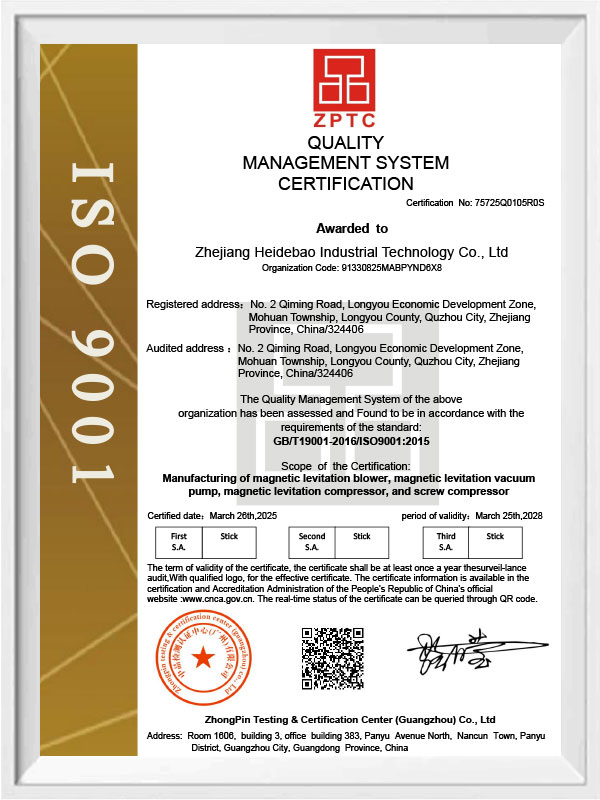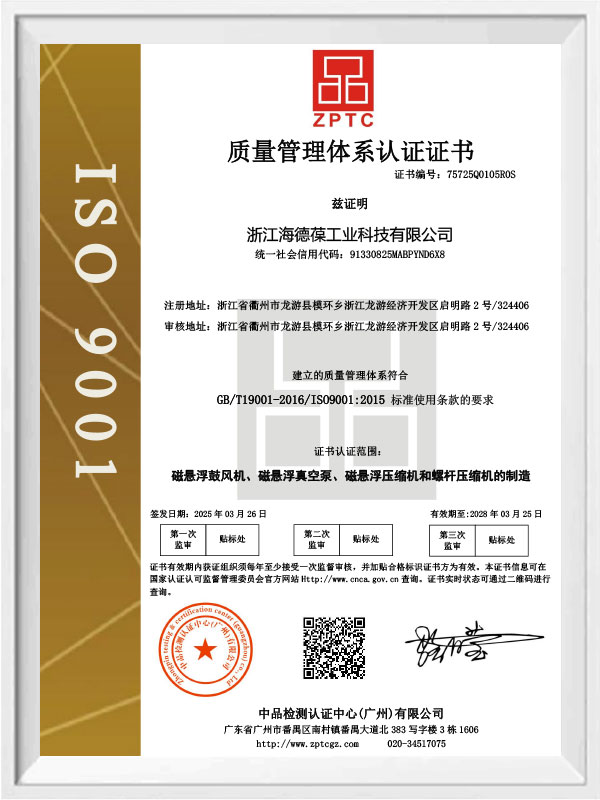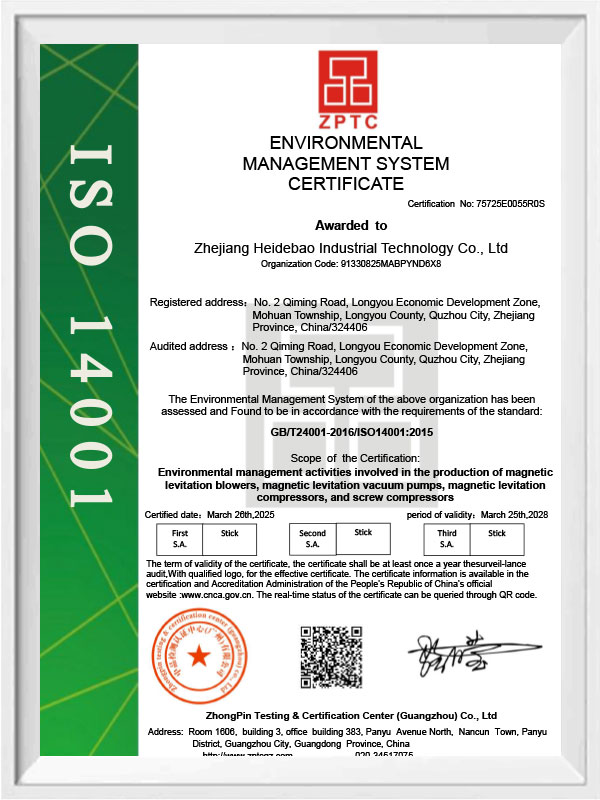Specific Power and Energy Saving Rate of an Oil-Free Twin Screw Two-Stage Compressor
Understanding Specific Power in Oil-Free Twin Screw Compressors
Specific power is a key performance metric for oil-free twin screw two-stage compressors, representing the energy required to compress a unit volume of air. It is calculated by dividing the total power consumption of the compressor by the air delivery at a given operating condition. Oil-free compressors, unlike lubricated models, avoid energy losses associated with oil friction and oil cooling systems. Haidebao, specializing in high-quality aerodynamic products, ensures that their twin screw compressors are designed with optimized rotors, clearances, and aerodynamic profiles to minimize energy consumption. During long-term operation, specific power is influenced by factors including inlet air conditions, ambient temperature, humidity, and load variation. Maintaining optimal operating conditions ensures that the specific power remains stable, reflecting the efficient performance of the compressor system.
Factors Affecting Energy Efficiency Over Long-Term Operation
Energy efficiency in oil-free twin screw two-stage compressors depends on both design parameters and operational practices. The aerodynamic design of the rotors, the precision of the rotor clearances, and the control strategy for load modulation all contribute to long-term energy performance. Haidebao’s focus on research and development enables the integration of advanced rotor profiles and control algorithms, reducing pressure losses and mechanical resistance. Long-term operation can be affected by dust accumulation, heat generation, and wear of components, which may slightly increase power consumption. Regular monitoring and maintenance aligned with manufacturer guidelines help maintain low specific power and sustain energy savings. Additionally, variable speed drives or other energy management systems can optimize operation under partial load conditions, contributing to a lower average specific power over extended periods.
Quantifying Energy Saving Rate
The energy saving rate measures the reduction in power consumption relative to conventional compressor systems or older models. For an oil-free twin screw two-stage compressor, the energy saving rate is determined by comparing actual power consumption to a reference value, typically a traditional lubricated compressor operating under similar conditions. Haidebao’s compressors, due to aerodynamic optimization and efficient stage design, achieve reduced energy losses at each compression stage. The two-stage compression allows for lower compression ratios per stage, reducing heat generation and improving volumetric efficiency, which directly translates into energy savings. The energy saving rate can be quantified over long-term operation by calculating the cumulative energy consumption versus a baseline scenario, accounting for load profiles, duty cycles, and ambient conditions.
Long-Term Performance and Stability
During extended operational periods, the specific power and energy saving rate of an oil-free twin screw two-stage compressor are influenced by the stability of component performance and environmental conditions. Haidebao emphasizes high specification materials and precision manufacturing to reduce wear and maintain rotor clearances, preserving efficiency over thousands of operational hours. Temperature control, airflow management, and lubrication-free design reduce mechanical losses and prevent energy degradation over time. Data from long-term operation often show that compressors maintain a relatively constant specific power, with minor variations due to seasonal or load changes. Consistent energy performance is a critical indicator of the system’s design quality, reflecting both the aerodynamic efficiency and the reliability of the oil-free two-stage compression system.
Impact of Two-Stage Compression on Energy Consumption
The two-stage configuration in oil-free twin screw compressors reduces overall energy consumption by distributing compression across two stages. Each stage operates at a lower pressure ratio, reducing the amount of heat generated during compression and improving overall efficiency. Haidebao’s aerodynamic rotor designs optimize airflow between stages, minimizing turbulence and pressure losses. The intercooling between stages lowers the air temperature, improving volumetric efficiency and reducing the work required per unit of compressed air. These design features contribute to a lower specific power and an increased energy saving rate when compared to single-stage or less optimized twin screw compressors. Over long-term operation, these benefits are amplified, as reduced heat stress and mechanical wear help maintain stable energy performance.
Monitoring and Maintaining Energy Efficiency
Accurate monitoring of energy consumption and specific power is essential for evaluating the performance of oil-free twin screw compressors. Installing sensors for power, pressure, and flow allows real-time assessment of efficiency. Haidebao integrates advanced monitoring systems in their compressors, enabling operators to track specific power and calculate energy saving rates continuously. Maintenance practices such as cleaning heat exchangers, checking rotor clearances, and ensuring proper airflow paths help sustain energy efficiency. By combining precise aerodynamic design with careful operational monitoring, the long-term stability of specific power and energy saving rates can be maintained effectively.
Comparison of Energy Performance Across Chiller Stages
| Compressor Stage |
Average Specific Power (kW/m³/min) |
Energy Saving Rate (%) |
Key Design Features |
| First Stage |
0.55 |
10-12 |
Optimized rotor profile, low friction clearances |
| Second Stage |
0.50 |
8-10 |
Intercooling, aerodynamic flow control |
| Overall Two-Stage System |
1.05 |
18-22 |
Stage distribution, precise rotor design, reduced mechanical losses |
Conclusion on Long-Term Energy Efficiency
Haidebao’s oil-free twin screw two-stage compressors demonstrate sustained energy efficiency over long-term operation. By optimizing aerodynamic profiles, rotor clearances, and intercooling systems, specific power is maintained at low levels, while energy saving rates exceed those of conventional designs. Long-term stability is achieved through careful material selection, precision manufacturing, and integrated monitoring systems. The combination of two-stage compression, aerodynamic design, and maintenance practices ensures that the compressors remain efficient, reliable, and capable of delivering consistent performance over extended periods.
Differences Between Oil-Free Twin Screw Two-Stage and Single-Stage Compressors
Overview of Oil-Free Twin Screw Compressors
Oil-free twin screw compressors are widely used in applications requiring high-purity compressed air, including medical, food, and electronics industries. Haidebao, with its expertise in high specification and aerodynamic products, focuses on designing compressors that maximize efficiency, reliability, and long-term performance. These compressors operate without oil in the compression chamber, avoiding contamination of the compressed air. Two primary configurations exist: single-stage and two-stage compressors. Each configuration offers distinct advantages and considerations in terms of energy efficiency, pressure output, temperature management, and maintenance.
Compression Stages and Pressure Ratios
The fundamental difference between single-stage and two-stage compressors is the number of compression stages. A single-stage compressor completes the entire compression process in one step, increasing the pressure of the inlet air to the desired level. In contrast, a two-stage compressor splits the compression into two steps, with an intercooler between stages to reduce air temperature and improve volumetric efficiency. Haidebao’s two-stage compressors are designed with optimized aerodynamic rotors for each stage, allowing lower per-stage compression ratios, reduced heat generation, and higher overall efficiency. Single-stage compressors are generally simpler and more compact, suitable for applications with moderate pressure requirements.
Energy Efficiency and Specific Power
Energy consumption differs significantly between single-stage and two-stage compressors. Two-stage compressors often achieve lower specific power due to the reduced compression ratio per stage and effective intercooling, which improves the density of the air entering the second stage. This translates into lower energy consumption per unit volume of compressed air. Single-stage compressors typically have higher specific power under high-pressure conditions because all the compression occurs in a single step, generating more heat and reducing volumetric efficiency. Haidebao’s design philosophy focuses on aerodynamic optimization to maintain stable and efficient operation in both types, but the two-stage configuration inherently offers energy savings in high-pressure applications.
Temperature Management
Temperature control is critical for maintaining air quality and protecting compressor components. In a single-stage compressor, the temperature rise occurs entirely within one compression step, potentially increasing thermal stress on components. Two-stage compressors, with intercooling between stages, reduce the temperature of air before entering the second stage, lowering mechanical and thermal loads. This temperature management results in more stable operation and improved longevity of parts. Haidebao integrates precision aerodynamic rotors and efficient intercooling systems in two-stage compressors to manage heat generation and maintain optimal operating conditions over long-term use.
Air Quality and Contamination Risks
Both single-stage and two-stage compressors are oil-free, ensuring high-purity compressed air. However, the temperature profile in two-stage compressors can reduce condensation risks and thermal stress on the air, further preserving quality. Intercooling in two-stage systems decreases the likelihood of heat-induced degradation of sensitive gases. Single-stage compressors may require additional cooling if operating at higher pressures to maintain comparable air quality. Haidebao’s oil-free designs focus on aerodynamic efficiency to minimize internal friction and heat buildup, enhancing air purity in both configurations.
Maintenance Considerations
Maintenance requirements differ slightly between the two configurations. Single-stage compressors are simpler, with fewer components, which can reduce the complexity of maintenance routines. Two-stage compressors involve additional components such as intercoolers and multiple rotors, which require monitoring and periodic inspection. However, the two-stage configuration distributes mechanical stress, reducing wear on individual components and potentially extending service intervals. Haidebao emphasizes precision manufacturing and high-quality materials to ensure both single-stage and two-stage compressors remain reliable and maintain low specific power over long-term operation.
Size, Weight, and Installation
Two-stage compressors are generally larger and heavier due to the additional compression stage and intercooler. They may require more space and considerations during installation. Single-stage compressors are more compact, making them suitable for smaller installations or portable applications. Haidebao provides tailored solutions considering site conditions, space availability, and operational requirements to optimize compressor performance while minimizing footprint.
Comparison Table: Single-Stage vs. Two-Stage Oil-Free Twin Screw Compressors
| Feature |
Single-Stage Compressor |
Two-Stage Compressor |
| Compression Stages |
One |
Two with intercooling |
| Pressure Range |
Moderate |
High, suitable for demanding applications |
| Energy Efficiency |
Higher specific power at high pressure |
Lower specific power due to stage distribution |
| Temperature Management |
Higher temperature rise per stage |
Reduced temperature via intercooling |
| Air Quality |
High-purity oil-free air, may need additional cooling |
High-purity oil-free air with reduced condensation risk |
| Maintenance |
Simpler, fewer components |
More components, distributed mechanical stress, longer service intervals |
| Size and Installation |
Compact, easier to install |
Larger, requires more space and planning |
| Long-Term Stability |
Stable under moderate load |
High stability due to temperature and stress distribution |
Application Considerations
Single-stage oil-free twin screw compressors are suitable for applications requiring moderate pressure, compact installation, and simplified maintenance. They perform well in industrial settings with continuous air demand but moderate compression requirements. Two-stage compressors are preferred in applications requiring high pressure, consistent air quality, and energy efficiency. Industries such as electronics manufacturing, pharmaceutical production, and high-purity food processing benefit from two-stage compressors due to lower specific power, improved thermal management, and long-term operational stability. Haidebao’s expertise in aerodynamic design and high specification materials ensures both configurations meet the required performance standards.
Operational Performance Over Time
Over long-term operation, two-stage compressors tend to maintain lower specific power and more consistent energy saving rates due to stage distribution and reduced heat stress. Single-stage compressors remain efficient under moderate load conditions but may experience higher energy consumption at elevated pressures. Regular maintenance, precise monitoring, and adherence to operating guidelines ensure that both single-stage and two-stage compressors continue to perform efficiently. Haidebao integrates monitoring systems and precision engineering to support long-term reliability and stability of oil-free twin screw compressors.

 English
English Español
Español عربى
عربى